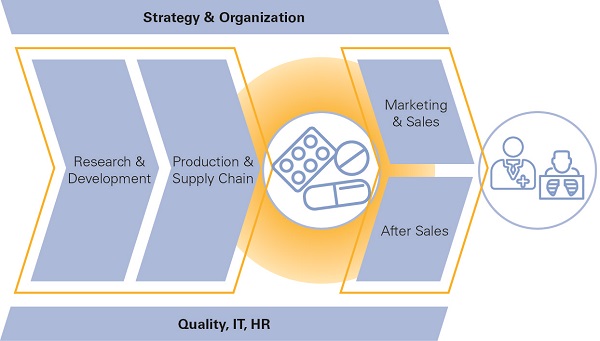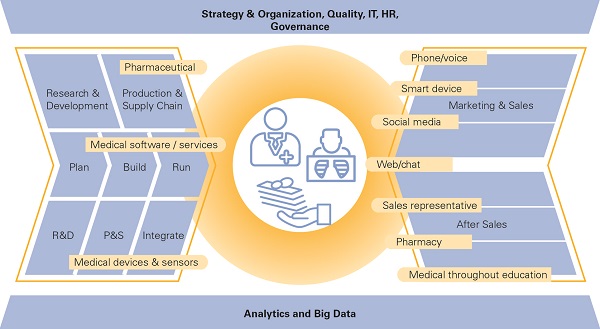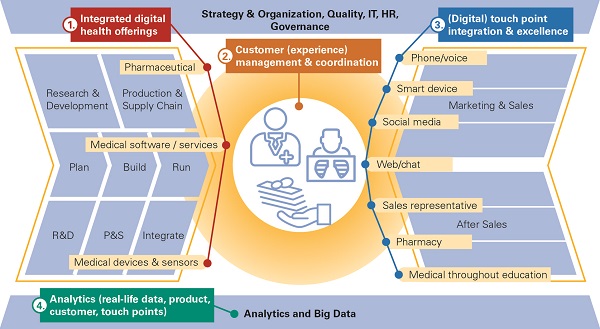Applying outside innovation to healthcare

Companies with new technologies and approaches are entering healthcare, and challenging pharma's traditional dominance in the sector. Pharmaceutical companies will need to undergo major transformation programmes and convert their value chains, say consultants Arthur D Little.
Today we are already seeing pharma companies such as Merck (through its patient engagement platform, Merckengage) and AbbVie (with a video solution for the management of Parkinson's Disease with Karolinska University Hospital) making initial steps towards offering a range of basic services that support important areas such as patient compliance, adherence or interdisciplinary collaboration. But the world can expect many more innovations to be applied to healthcare by pharma companies. Big data will enable them to measure the real-life effects of their medicines, while fully integrated services will improve the quality and efficiency of care.
Calico, Google's new health-focused division is aiming to tackle one of the biggest challenges, ageing
In order to implement such integrated solutions ahead of new entrants such as Calico (established by Google and with an R&D partnership with AbbVie), pharma companies will need to undergo major transformation programmes and convert their value chains. This article outlines the nature and origins of the disruptive pressure on the pharmaceutical industry and how companies should transform themselves to respond to the challenges and opportunities arising from this new era of digitalization.
Non-traditional entrants driving change
Many of the innovative solutions that digital health offers are being developed by non-traditional entrants to the healthcare arena. They are now providing new offerings that are very quickly changing the dynamics of how the ecosystem works, and, in particular, how the individual patient is engaged.
One telling measure is the amount of venture capital that is continuing to flow into the digital health market. According to digital health start-up accelerator Rock Health, $2.1 billion was invested in digital health start-ups during the first half of 2015 – up 25% compared to the previous 12 months. The biggest portion, $387 million, went to wearables and biosensing companies, but analytics and big data, as well as electronic health records, are other categories that are seeing significant investment activity and a vibrant innovation environment.
It is becoming clear that in order to stay relevant in the future healthcare ecosystem, pharma companies must look to business models that foster much more direct patient engagement than previously. New methods offer significant potential to increase the quality and efficiency of care. Digital health solutions could therefore solve the major long-term issues of pharma's most important client groups – patients, providers and payers – all at the same time.
Understanding the disruptive power of digital health
In order to understand the disruptive power of digital health and its impact on pharma, one has to take a closer look at the relationships within this well-connected ecosystem. Traditionally, healthcare providers, payers and pharma companies have had a conventional supplier-consumer relationship. However, there are now increasing demands from payers and providers around the delivery of better health outcomes and greater cost-effectiveness. These provide a strong driving force for pharma companies to more actively engage in the opportunities arising from the digital revolution and patient-centred care. More than ever, regulatory bodies now insist on pharma companies demonstrating benefits and cost-effectiveness, with many countries introducing reforms that aim to restrain overall spending. Ensuring responsiveness to treatment and patient compliance, while minimising side effects, are therefore key success factors if pharma companies are to meet society's demands.
Achieving the new success factors
In order to achieve these new success factors, pharma companies need to begin a process of transformation. The proven classical, product-centric approach with an indirect value chain (as shown in Table 1)

will not be able to embrace the required speed, new collaboration needs, flexibility and ability to learn quickly. A pharma value chain in a digitalised environment needs to incorporate new characteristics. Therefore, as a first step, the company needs to develop a vision of how it will earn money in the new digitalised world. Will the revenue model stay? Will the business model instead be built around new manufactured products or services? What will the portfolio and customer experience look like? A vision of how a transformed organisation can be structured is shown in Table 2.

In such a vision, pharmaceutical product offerings can be strengthened through complementary digital software/digital services offerings. These help patients with their treatment, help practitioners with their work, and give them insight into the success of their treatments, while helping payers and legal entities to receive proof of efficacy. Depending on the pharmaceutical product, medical devices and sensors will measure the consistency of product usage and its success. The combination of all three product groups results in an integrated digital health offering that is able to give a new competitive advantage.
The "customer" is at the centre of this vision. This includes not just the patient/consumer, but also the practitioner and the payer. All products and services, as well as all administrative processes, focus on long-term customer value through customer group-specific journeys.
To create action plans and concrete initiatives, the transformational need has to be cascaded down to processes, data and technology requirements, and management capabilities. The major challenge to success is the need to integrate organisations, concepts, processes and technology. A successful transformation programme typically incorporates the major pillars of the new vision within four fields of action, as shown in Table 3: Integrated offerings, customer management and co-ordination, digital touch-point integration and excellence, and analytics (real-life data, product and customer touch points).

The innovations coming from outside the traditional healthcare industry span a wide spectrum of products and services, but all take advantage of advances in digital technologies and the ability to analyse and present large amounts of data in new ways. From new biosensor technologies and smart devices to portals and physician guidance tools, there are numerous exciting breakthroughs that allow enhanced self-monitoring capabilities and patient adherence – and ultimately superior clinical decision-making and treatment success.
About the authors:

Dr Ulrica Sehlstedt is a Partner in the Stockholm office of Arthur D. Little and a member of the Global Healthcare Practice.

Nils Bohlin is a Partner in the Stockholm office of Arthur D. Little and leads the Global Healthcare Practice.

Fredrik de Maré is a Partner in the San Francisco office of Arthur D. Little and leads the US West Coast Healthcare Practice.

Dr Richard Beetz is a Principal in the Frankfurt office of Arthur D. Little and a member of the Global Technology and Innovation Management Practice













